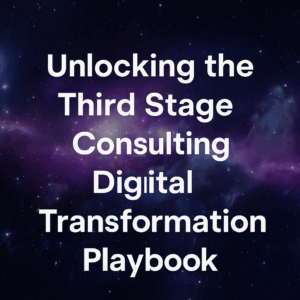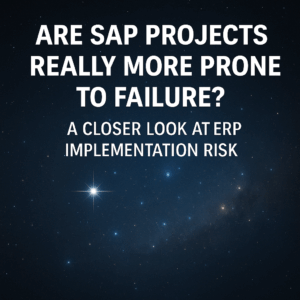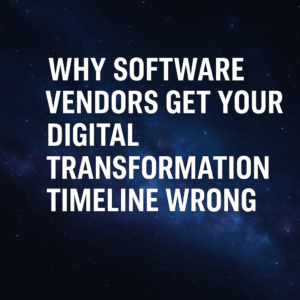Introduction
The implementation of an Enterprise Resource Planning (ERP) system represents a substantial operational and cultural shift within an organization. It is a strategic investment that has the potential to improve efficiency, streamline processes, and provide a unified view of the business. However, the path to a successful ERP implementation is often fraught with challenges that can undermine the effectiveness of the system and, in some cases, lead to project failure. Understanding these challenges is the first step toward overcoming them and ensuring a successful integration of an ERP system into your business operations. To learn more about why ERP implementations fail, check out our Digital Stratosphere Podcast episode – Why ERP Implementations Fail | Root Causes of ERP Failures.
Table of Contents
ToggleChallenges of ERP Implementations

1. Ensuring Top Management Support
The journey of ERP implementation is as much about technology as it is about vision, leadership, and organizational alignment. Ensuring top management support isn’t just about getting a nod for budget allocation; it’s about securing a commitment from the highest levels of the organization to champion the project throughout its lifecycle. Executive buy-in is the bedrock upon which the success of an ERP implementation is built. When top management leads from the front, it sends a clear message across the organization about the strategic importance of the project.
- List of Challenges:
- Securing sustained commitment from top-level executives.
- Aligning the ERP project with strategic business goals.
- Acquiring adequate resources and budget.

2. Adequate Resource Allocation
The implementation of an ERP system is a resource-hungry process that often stretches the operational limits of an organization. When resources — be it time, money, or personnel — are in short supply, the project can suffer at various critical junctures. Inadequate resource allocation can lead to corners being cut, critical steps being rushed, or essential training being overlooked, each of which can severely compromise the success of the implementation.
For a process that is as detailed and integral as ERP implementation, every phase requires meticulous attention and adequate resources. This scarcity becomes more pronounced when the organization continues to juggle its day-to-day operations alongside the implementation. Without a carefully crafted plan that ensures resources are available as and when they are needed, the organization may find itself grappling with delayed timelines, ballooning costs, and a workforce stretched to its limits, all of which can cast a long shadow on the eventual effectiveness of the ERP system.
- List of Challenges:
- Allocating skilled personnel to the project.
- Providing sufficient financial resources.
- Managing the impact on day-to-day operations.
Conclusion: A clear resource allocation plan must be developed to ensure the project has the required inputs without jeopardizing regular business functions.
3. Effective Change Management
Change management is the lifeblood of a successful ERP implementation, for the introduction of such a system is more than a mere shift in technology—it’s a transformation of the business itself. An ERP system touches every aspect of how a company operates, necessitating not only new processes but also a new culture. Employees at all levels must understand, adapt to, and ultimately embrace a new way of working, where resistance is an expected reaction. Navigating this change requires a considered strategy that involves clear communication, comprehensive training, and a support structure to help employees transition through the various stages of the change curve.
Without a robust change management plan, the ERP implementation can result in confusion, low morale, and a workforce that is not aligned with the organization’s objectives, leading to underutilization of the new system and, at worst, project failure. Therefore, managing change effectively is not simply a component of an ERP rollout; it is an essential thread that must be woven into the fabric of the implementation from its conception to its final execution.
- List of Challenges:
- Communicating changes effectively to all stakeholders.
- Training employees to adapt to new processes.
- Dealing with resistance to change.
Conclusion: A structured change management strategy that prioritizes communication, training, and support can mitigate resistance and facilitate a smoother transition.

4. Data Quality and Transfer
The transition to a new ERP system often pivots on the axis of data integrity. As the lifeblood of the organization, data must be migrated with utmost precision; any errors in transfer—be it incomplete datasets, inaccuracies, or duplication—can lead to significant operational disruptions post-implementation. The effectiveness of an ERP system is inextricably linked to the quality of the data it processes. Clean, accurate, and well-structured data ensures that the system functions as intended, providing reliable insights and supporting effective decision-making.
Achieving this level of integrity requires rigorous planning, with a comprehensive data audit and cleansing prior to migration. It also demands a well-thought-out strategy for the migration itself, one that minimizes downtime and ensures that the data’s integrity is maintained in its new digital residence. This step is not merely a technical formality but a strategic initiative that has far-reaching implications for the organization’s continued efficiency and its ability to harness the full potential of the ERP solution.
- List of Challenges:
- Cleansing and preparing existing data for migration.
- Ensuring the accuracy and completeness of data.
- Transferring data without disrupting current operations.
Conclusion: Diligent planning and execution of data migration strategies are necessary to ensure data quality and system reliability.
5. Customization and Integration
Customization is a double-edged sword in the realm of ERP implementations. On one hand, it allows the ERP solution to be tailored to the unique processes and needs of a business, potentially providing a competitive edge by aligning the software closely with the organizational workflow. On the other hand, excessive customization can entangle the project in a web of complexity, making it a Herculean task to ensure that all the modified components work harmoniously with one another and with any existing systems. This complexity doesn’t just end with the implementation phase; it extends into the future, complicating upgrades and scaling efforts, and often resulting in increased costs and maintenance challenges.
Therefore, while customizing an ERP system, it is critical to strike a balance. The aim should be to adapt the system to the business in a way that adds value, without straying too far from the software’s core functionality and design. Businesses must consider not just the immediate benefits of customization, but also the long-term implications on system stability, supportability, and the ability to stay current with technological advances. Effective customization is about enhancing functionality, not compromising it, ensuring that the ERP system remains a robust and agile tool that grows with the business.
- List of Challenges:
- Balancing between out-of-the-box functionality and custom features.
- Integrating the ERP system with existing applications.
- Upgrading customized systems.
Conclusion: Customization decisions should be made judiciously, with a focus on maintaining the system’s ability to upgrade and integrate with other platforms.

6. Testing and Quality Assurance
Adequate testing stands as the guardian at the gates of ERP implementation, serving to detect and defend against potential failures before they manifest in a live environment. This phase is not merely a formality, but a critical evaluation of the system’s readiness, an in-depth analysis that seeks to uncover any discrepancies that could jeopardize the system’s operational integrity. A comprehensive testing phase subjects the ERP solution to a battery of scenarios, ranging from common daily tasks to rare and complex transactions, to ensure that every facet of the system operates as intended under all possible conditions. It is during this stage that the theoretical promises of the ERP solution are put to the sternest practical tests.
Neglecting this step can lead to devastating consequences when the system is operational, from minor disruptions in workflow to catastrophic failures that could halt the entire operation. Furthermore, testing provides a valuable training ground for the end-users, acclimatizing them to the new system in a controlled environment where errors are learning opportunities rather than critical mistakes. A rigorous and meticulous testing process, therefore, lays the foundation for a smooth transition to the new ERP system, ensuring not just functionality, but also confidence in the new digital ecosystem that will drive the business forward.
- List of Challenges:
- Developing comprehensive test plans.
- Allocating time for thorough testing.
- Ensuring user involvement in the testing process.
Conclusion: Rigorous and systematic testing, with end-user involvement, will help in identifying and rectifying problems early in the implementation phase.
7. Post-Implementation Support
The successful deployment of an ERP system is not the finish line; it is the starting block from which the organization embarks on a continuous journey of optimization and innovation. The conclusion of an ERP implementation project marks a significant milestone, where the intricate planning, development, and testing phases give way to actual operation and utilization. However, this transition also ushers in a new set of challenges and opportunities for growth. Post-implementation, the system enters a critical phase where it must not only support current business operations but also adapt to evolving business strategies, regulatory changes, and technological advancements.
This ongoing lifecycle means that the organization must commit to continuous monitoring, maintenance, and improvement of the ERP system. Regular assessments are crucial to identify and address any post-deployment issues promptly, and to align the system with the changing needs of the business. Training and support become ongoing tasks to ensure that the system continues to be used to its full potential as users grow more adept and as new features are released. In this sense, the real value of an ERP system is realized in the days and years after the initial go-live, as it becomes deeply ingrained in the company’s fabric, driving efficiency, providing insights, and facilitating growth. The post-implementation era is where the ERP system truly starts to deliver on its promise of transforming the business.
- List of Challenges:
- Providing continuous technical support to users.
- Managing updates and system enhancements.
- Ensuring the ERP system scales with the business.
Conclusion: Post-implementation, ongoing support and enhancement plans are vital for the continued success and relevance of the ERP system.
Conclusion
Implementing an ERP system can be a daunting endeavor, but with the right approach, the obstacles can be transformed into stepping stones for success. Businesses must navigate these challenges with strategic planning, diligent resource allocation, effective change management, a commitment to data integrity, smart customization, thorough testing, and robust post-implementation support.
By acknowledging and preparing for these challenges, organizations can ensure a smoother transition to a more integrated and efficient system that supports their long-term business objectives. Ultimately, the right ERP solution, implemented effectively, can become the backbone of a company’s operations, driving efficiency, and providing the insights necessary for strategic decision-making.
I would enjoy brainstorming ideas with you if you are looking to strategize for an upcoming transformation or are looking at selecting an ERP system. Please feel free to contact me at eric.kimberling@thirdstage-consulting.com. I am happy to be a sounding board as you continue your digital transformation journey.





